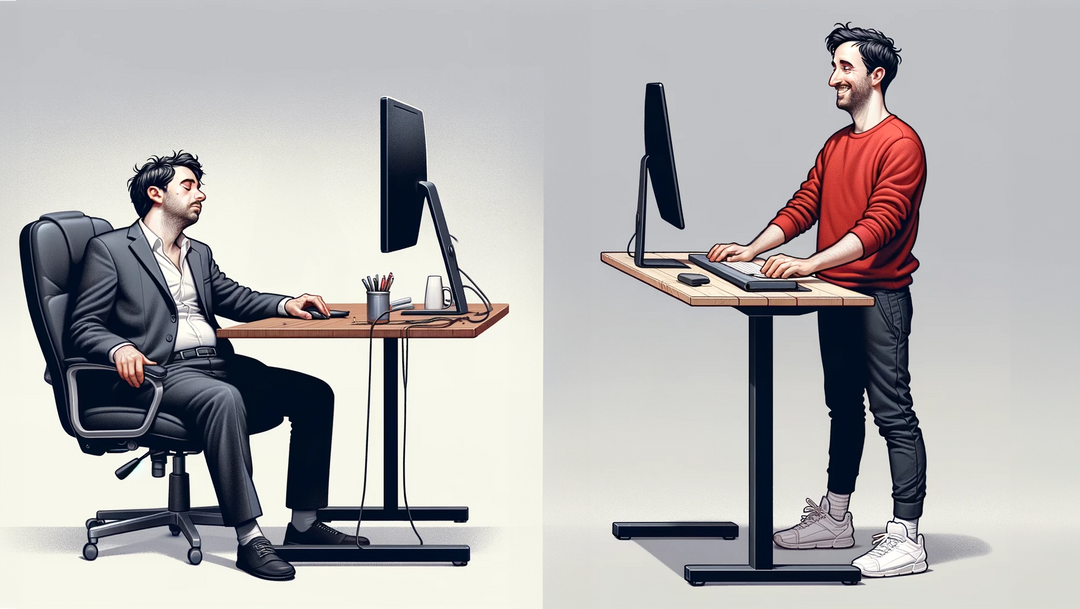Standing at Desk Better Than Sitting at Desk?
There has been significant research in recent years comparing the effects of standing versus sitting at work, and understandably so. On average, Americans working desk jobs spend approximately 8.8 hours per day sitting hunched over at their desks. The debate between standing desks and sitting desks have gained significant attention. Many individuals are exploring alternative work setups to combat the adverse effects of prolonged sitting. This article aims to provide a comprehensive analysis of standing desks versus sitting desks, shedding light on their pros, cons, and overall impact on health and productivity.
Understanding Standing Desks
Standing desks, also known as stand-up desks or height-adjustable desks, allow users to work while standing upright or sitting. These desks come in various designs, including manual, electric, and convertible models. Adjustable standing desks offer the flexibility to switch between standing and sitting positions, promoting ergonomic movement throughout the workday.
Reasons to Stand by Your Standing Desk
According to Harvard Health Publishing, a standing desk is unlikely to help with weight loss or avoiding weight gain, there may be other reasons to stand while you work. Advocates of standing desks point to studies showing that after a meal, blood sugar levels return to normal faster on days a person spends more time standing. standing, rather than sitting, may reduce the risk of shoulder and back pain.
Other potential health benefits of a standing desk are assumed based on the finding that long hours of sitting are linked with a higher risk of:
- Obesity
- Diabetes
- Cardiovascular disease
- Cancer (especially cancers of the colon or breast)
- Premature death
But "not sitting" can mean many different things — walking, pacing, or just standing — and as the new study on energy expenditure shows, the health effects of these may not be the same. For most of these potential benefits, rigorous studies of standing desks have not yet been performed. So, the real health impact of a standing desk is not certain. You can have a look at our rich assortment of standing desks over here!
Drawbacks of Standing Desks
Despite their advantages, standing desks have certain drawbacks that users should consider. Prolonged standing can lead to fatigue and discomfort, especially for individuals unaccustomed to this position. Moreover, standing for extended periods may increase the risk of varicose veins and cardiovascular issues due to reduced circulation. Additionally, some users find it challenging to maintain focus and productivity while standing, especially during prolonged tasks. Furthermore, overuse of standing desks without adequate rest may contribute to musculoskeletal injuries over time.
Comparative Analysis: Standing Desk vs. Sitting Desk
When comparing standing desks to sitting desks, it's essential to weigh their respective pros and cons. While standing desks offer benefits such as improved posture and increased calorie expenditure, sitting desks provide comfort and stability for prolonged tasks. However, excessive sitting has been linked to various health concerns, including obesity and cardiovascular disease. Therefore, finding a balance between sitting and standing throughout the workday is crucial for overall well-being.
Addressing Common Concerns
Common concerns regarding standing desks include their long-term health implications and optimal duration for standing. While standing all day may not be advisable, experts recommend alternating between sitting and standing every 30 to 60 minutes to prevent discomfort and fatigue. Additionally, standing desks alone may not build muscle significantly, but incorporating movement and exercise breaks can contribute to overall physical health.
Practical Tips for Desk Workers
Regardless of desk type, ergonomic considerations are vital for maintaining comfort and preventing injury. Desk workers should ensure proper desk and chair height, monitor placement, and foot support to promote neutral body alignment. Taking regular breaks to stretch and move around can alleviate stiffness and promote circulation. Simple exercises like shoulder rolls, leg stretches, and desk push-ups can be incorporated into the work routine to combat the effects of prolonged sitting or standing.
Real-life Experiences and Perspectives
Many individuals have successfully transitioned to standing desks and shared their experiences. While some users report significant improvements in energy levels and productivity, others face challenges such as leg fatigue and discomfort. Recommendations for those considering a switch include gradually transitioning to standing, investing in anti-fatigue mats, and wearing supportive footwear.
Conclusion
In conclusion, the debate between standing desks and sitting desks revolves around finding the right balance for individual needs and preferences. Both options offer unique benefits and drawbacks, emphasizing the importance of ergonomic awareness and regular movement in the workplace. By incorporating practical tips and insights from real-life experiences, individuals can optimize their work setups for improved health and productivity.









Leave a comment